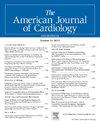基于血管的微血管阻力,冠状动脉微血管功能障碍严重程度的量度,对肥厚性心肌病患者心房颤动的意义。
IF 2.1
3区 医学
Q2 CARDIAC & CARDIOVASCULAR SYSTEMS
引用次数: 0
摘要
冠状动脉微血管功能障碍(CMD)是肥厚性心肌病(HCM)患者的共同特征。CMD是普通人群心房颤动(AF)的危险因素。然而,HCM患者中CMD与房颤患病率之间的关系尚未得到充分探讨。本研究旨在探讨基于血管的微血管阻力(AMR),作为冠状动脉微循环功能的指标,是否与大量HCM患者房颤患病率相关。共纳入607例接受冠状动脉造影的HCM患者。采用冠状动脉无线造影方法回顾性计算AMR, AMR平均值≥250 mmHg*s/m定义为CMD的指示。我们的研究结果显示,CMD患者多为男性,吸烟率和高血压患病率较高。在CMD患者中,房颤患病率增加(26.3% vs 11.0%, P < 0.001),或在AHI四分位数中分别增加(7.1%,11.3%,16.2%和26.8%,P为趋势本文章由计算机程序翻译,如有差异,请以英文原文为准。
Implication of Angio-based Microvascular Resistance, A Measure of Coronary Microvascular Dysfunction Severity, for Atrial Fibrillation in Patients With Hypertrophic Cardiomyopathy
Coronary microvascular dysfunction (CMD) is a common feature in patients with hypertrophic cardiomyopathy (HCM). CMD is a risk factor for atrial fibrillation (AF) in the general population. However, the relationship between CMD and AF prevalence in HCM patients has not been fully explored. This study aimed to investigate whether angio-based microvascular resistance (AMR), as an index of coronary microcirculatory function, is associated with the prevalence of AF in a large cohort of HCM patients. A total of 607 patients with HCM who underwent coronary angiography were included. AMR was retrospectively calculated using a wire-free angiography method in coronary arteries, and an average value of AMR ≥250 mmHg*s/m was defined as indicative of CMD. Our results showed that patients with CMD were more often male, with higher smoking rates and a higher prevalence of hypertension The prevalence of AF increased in patients with CMD (26.3% vs 11.0%; p <0.001), or across AHI quartiles (7.1%, 11.3%, 16.2%, and 26.8%, respectively; P for trend <0.001). After adjusting for age, sex, BMI, Hyperlipidemia, hypertension, left atrial diameter, creatinine and obstructive HCM, the presence of CMD (odds ratio, 3.12; 95% CI 1.89 to 5.18, p <0.001) or highest AMR quartile (odds ratio, 6.08 95% CI 2.76 to 13.38, p <0.001) were significantly associated with AF. In conclusion, AMR, as a marker of microvascular dysfunction, is independently associated with the prevalence of AF in patients with HCM. For HCM patients, these findings suggest that evaluating AMR could provide valuable insights into the risk of AF.
求助全文
通过发布文献求助,成功后即可免费获取论文全文。
去求助
来源期刊

American Journal of Cardiology
医学-心血管系统
CiteScore
4.00
自引率
3.60%
发文量
698
审稿时长
33 days
期刊介绍:
Published 24 times a year, The American Journal of Cardiology® is an independent journal designed for cardiovascular disease specialists and internists with a subspecialty in cardiology throughout the world. AJC is an independent, scientific, peer-reviewed journal of original articles that focus on the practical, clinical approach to the diagnosis and treatment of cardiovascular disease. AJC has one of the fastest acceptance to publication times in Cardiology. Features report on systemic hypertension, methodology, drugs, pacing, arrhythmia, preventive cardiology, congestive heart failure, valvular heart disease, congenital heart disease, and cardiomyopathy. Also included are editorials, readers'' comments, and symposia.
 求助内容:
求助内容: 应助结果提醒方式:
应助结果提醒方式:


